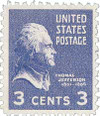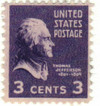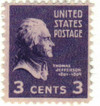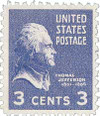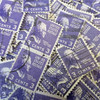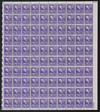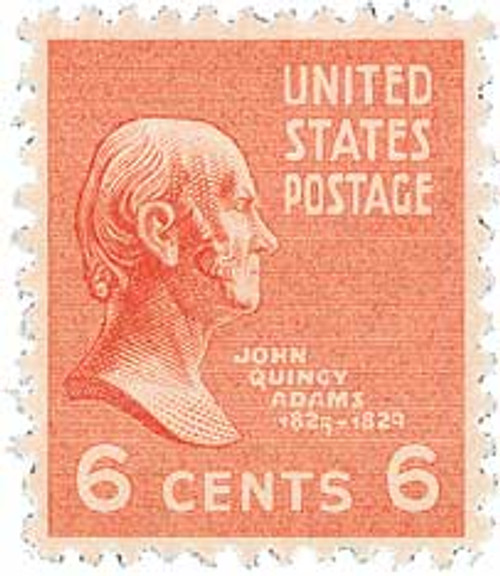
# 807 - 1938 3c Jefferson, purple
1938 3¢ Thomas Jefferson
Presidential Series
Issue Date: June 16, 1938
First City: Washington, DC
Quantity Issued: 87,101,233
Printing Method: Rotary press
Perforations: 11 x 10 ½
Color: Deep violet
Jefferson Counterfeits
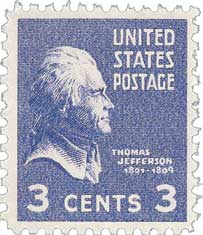
On June 16, 1938, the post office issued a 3¢ Jefferson stamp, which was convincingly counterfeited.
The 3¢ Jefferson stamp was the fifth issue in the popular Presidential Series, affectionately known as the Prexies. The series was issued in response to public clamoring for a new Regular Issue series, as the current series had been in use for more than a decade.
.jpg)
Franklin Roosevelt, the stamp-collecting President, personally approved every stamp. Every US President deceased when the series was created was honored. Americas first 29 Presidents were featured on stamps with denominations corresponding to the numerical order of their term of office. In addition to the Presidents, Benjamin Franklin, Martha Washington, and the White House were commemorated.
On June 16, 1938, the Thomas Jefferson stamp was placed on sale. Paying the 3¢ first-class letter rate, the Jefferson stamp was the most commonly used and in-demand stamp of the series. In fact, it would remain in use even after a new series was issued in the 1950s until 1958. It would be produced in booklet, sheet, and coil format over the course of the series.
.jpg)
In New York City, 33-year-old Nathan Levine developed a scheme. Using a blend of photography and lithograph printing, he produced counterfeited copies of the 1938 3¢ Thomas Jefferson stamp. Levine easily sold sheets of 100 perforate and imperforate stamps for $1.75 each until his 1949 arrest. Today, his counterfeits are more valuable than the genuine stamp, which is a seldom occurrence.
1938 3¢ Thomas Jefferson
Presidential Series
Issue Date: June 16, 1938
First City: Washington, DC
Quantity Issued: 87,101,233
Printing Method: Rotary press
Perforations: 11 x 10 ½
Color: Deep violet
Jefferson Counterfeits

On June 16, 1938, the post office issued a 3¢ Jefferson stamp, which was convincingly counterfeited.
The 3¢ Jefferson stamp was the fifth issue in the popular Presidential Series, affectionately known as the Prexies. The series was issued in response to public clamoring for a new Regular Issue series, as the current series had been in use for more than a decade.
.jpg)
Franklin Roosevelt, the stamp-collecting President, personally approved every stamp. Every US President deceased when the series was created was honored. Americas first 29 Presidents were featured on stamps with denominations corresponding to the numerical order of their term of office. In addition to the Presidents, Benjamin Franklin, Martha Washington, and the White House were commemorated.
On June 16, 1938, the Thomas Jefferson stamp was placed on sale. Paying the 3¢ first-class letter rate, the Jefferson stamp was the most commonly used and in-demand stamp of the series. In fact, it would remain in use even after a new series was issued in the 1950s until 1958. It would be produced in booklet, sheet, and coil format over the course of the series.
.jpg)
In New York City, 33-year-old Nathan Levine developed a scheme. Using a blend of photography and lithograph printing, he produced counterfeited copies of the 1938 3¢ Thomas Jefferson stamp. Levine easily sold sheets of 100 perforate and imperforate stamps for $1.75 each until his 1949 arrest. Today, his counterfeits are more valuable than the genuine stamp, which is a seldom occurrence.




